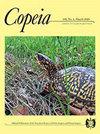Comprehensive Analysis of Salamander Hybridization Suggests a Consistent Relationship between Genetic Distance and Reproductive Isolation across Tetrapods
IF 2.6
Q2 Agricultural and Biological Sciences
引用次数: 4
Abstract
Hybridization between populations along the path to complete reproductive isolation can provide snapshots of speciation in action. Here, we present a comprehensive list of salamander hybrids and estimate genetic distances between the parental hybridizing species using one mitochondrial and one nuclear gene (MT-CYB and RAG1). Salamanders are outliers among tetrapod vertebrates in having low metabolic rates and highly variable sex chromosomes. Both of these features might be expected to impact speciation; mismatches between the mitochondrial and nuclear genomes that encode the proteins for oxidative metabolism, as well as mismatches in heteromorphic sex chromosomes, can lead to reproductive isolation. We compared the genetic distances between hybridizing parental species across four main tetrapod groups that differ in metabolic rates and sex chromosome diversity: salamanders, lizards, mammals, and birds. Our results reveal no significant differences, suggesting that variation in these traits across vertebrates does not translate into predictable patterns of genetic divergence and incompatible loci in hybrids.萨拉曼德杂交的综合分析表明,四足类之间的遗传距离与繁殖隔离具有一致的关系
沿着完全生殖隔离的路径,种群之间的杂交可以提供行动中的物种形成的快照。在这里,我们提出了一个全面的蝾螈杂交种列表,并估计亲本杂交物种之间的遗传距离使用一个线粒体和一个核基因(MT-CYB和RAG1)。在四足脊椎动物中,蝾螈具有低代谢率和高度可变的性染色体。这两个特征都可能影响物种形成;编码氧化代谢蛋白质的线粒体基因组和核基因组之间的不匹配,以及异型性染色体的不匹配,都可能导致生殖隔离。我们比较了四个主要四足动物群体中不同代谢率和性染色体多样性的杂交亲本物种之间的遗传距离:蝾螈、蜥蜴、哺乳动物和鸟类。我们的研究结果没有显示出显著的差异,这表明这些性状在脊椎动物之间的差异并没有转化为可预测的遗传分化模式和杂交中不相容的位点。
本文章由计算机程序翻译,如有差异,请以英文原文为准。
求助全文
约1分钟内获得全文
求助全文
来源期刊

Copeia
生物-动物学
CiteScore
2.10
自引率
0.00%
发文量
0
审稿时长
6-12 weeks
期刊介绍:
Founded in 1913, Copeia is a highly respected international journal dedicated to the publication of high quality, original research papers on the behavior, conservation, ecology, genetics, morphology, evolution, physiology, systematics and taxonomy of extant and extinct fishes, amphibians, and reptiles. Copeia is published electronically and is available through BioOne. Articles are published online first, and print issues appear four times per year. In addition to research articles, Copeia publishes invited review papers, book reviews, and compiles virtual issues on topics of interest drawn from papers previously published in the journal.
 求助内容:
求助内容: 应助结果提醒方式:
应助结果提醒方式:


